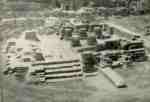PREPARATION - ADVISORY COMMITTEE AND THE TRUST
The draft Trust Deed, which required considerable amendments, was directed to be sent back to me.

 |
We started working on
July 30, 1949. Under our instructions, Prabhashankar Sompura, with
his wide knowledge of the ancient art of temple building, prepared a
plan of the new temple on the style of the old one. On October 18, 1949, Sardar nominated the first Trustees. Jam Saheb and Samaldas Gandhi were to represent Saurashtra Government. Gadgil, Minister for Works, Mines and Power, and D.V. Rege, Regional Commissioner of Saurashtra at Rajkot, were appointed as nominees of the Government of India. Brijmohan Birla and myself were appointed as representatives of the general public. Two vacancies were kept for future donors. Though not officially a Trustee, U.N. Dhebar, Chief Minister of Saurashtra, has been more than a Trustee, aiding, guiding and implementing all the activities of the Trust with rare conscientiousness. |
Sardar's message to Jam Saheb of
Nawanagar, which was conveyed in a D.O letter, dated November 22,
1949, from V. P. Menon, then Secretary, States Ministry, is as
follows: -"Your Highness
will recollect that you handed over to me a cheque for Rs. 1,00,000 (One
lakh) some time ago which I returned to you. I am now writing to suggest
that this amount may be paid as a donation to the Somanatha Fund.
Somanatha is an ancient heritage of ours, and we have to take every care
to see that the temple and its environments are maintained in a manner
worthy of their ancient traditions.
For this purpose, we propose to constitute a Trust. Your Highness will remember that Sardar made an appeal for funds for the Somanatha Trust some time ago. The object, therefore, is one which deserves full support from all patriotic Indians and that is why I am making this suggestion. I shall be grateful for a line in reply."
By the end of 1949, about Rs. 25 lakhs were collected. The Trust Deed was finally approved by the Government of India and Saurashtra Government and was executed on March 15, 1950.The objects of the Trust were thus fully
defined:
"(a) Upon trust to restore and reconstruct the said Temple of
Somanatha in such manner as may be determined in consultation with an
'Advisory Committee' to be constituted as hereinafter provided and to
incur the necessary expenses in connection therewith;
(b).Upon trust to instal or cause to be installed in the Temple of
Somanatha one or more idols of Shiva and other deities as are objects of
worship by the Hindu community;
(c).Upon trust to hold rituals, ceremonies and celebrations, necessary for
or connected with or incidental to the shrine of the deity referred to in
clauses (a) and (b);
(d).Upon trust to allow all members of the Hindu community without
distinction of caste, creed or sect to use the said Temple of Somanatha as
a place of worship and for offering prayers and performing rites and
ceremonies in accordance with the regulations that may be made in that
behalf and for such other religious or charitable purposes as the
Trustees may, from time to time, sanction but subject always to any
provisions contained in such regulations a the Trustees may
consider necessary to secure the safety and protection of the building;
(e) Upon trust to construct and maintain rest houses and dharmashalas for
the pilgrims visiting the said Temple of Somanatha; Upon trust to set up
one or more institutions, including a University, which has for its
objects the imparting of education, the essential features of which are-
(i) the religious education of Hindus,
(h) the imparting of knowledge of Sanskrit,
(iii) the study of or research in Sanskritic learning, Indology or any
branch of knowledge of which such knowledge or Indology forms part, and
iv.the spread of Sanskrit or Sanskritic learning or to popularise Hindu
scriptures or to get prepared or publish works which have for their object
the spread of Sanskrit, Sanskritic learning or Indology or which would
impart such education to the general public;
(g) Upon trust to renovate, reconstruct and maintain Dehotsarga, the
sacred place where Lord Shri Krishna departed from the world and to
construct a shrine and a suitable memorial thereon;
(h) Upon trust to allow non-Hindu visitors to visit the Somanatha Temple
and have darshana of the deities in accordance with the rules and
regulations that may, from time to time, be framed by the Trustees
provided that no such visitor shall be allowed personally to perform
worship in the said Temple of Somanatha;
(i) Upon trust to improve, beautify, and maintain the land, premises and
area leading to or in the neighbourhood of the said Temple of Somanatha
and to do such things as may add beauty, solemnity and sanctity to the
aforesaid Trust properties;
j.Upon trust to take over, maintain and conduct the temples, shrines and
sacred places situated on the Somanatha Estate or any other place;
(k) Upon trust to manage and develop the Somanatha Estate or any part
thereof in such manner as the Trustees may deem fit including setting up
buildings or agricultural farms or other schemes not repugnant to the
principal objects contained in clauses (a) to (h) hereof;
(k).Upon trust to maintain and develop goshalas for developing good breed
of cows and other cattle and a farm or farms for the same;
(m) Upon trust to take over, maintain, conduct and manage other public
Trusts of a religious or charitable nature which have as their objects the
maintenance, upkeep or conduct of any Hindu temple, shrine or sacred
place, the setting up, maintenance or conduct of any institution, one of
the features of which is the object specified in clauses (f) and (k)
thereof;
(n) Upon trust to do all things necessary, germane or incidental to the
aforesaid objects."